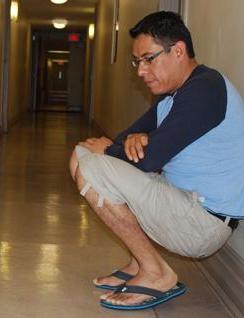The Ontario chief coroner announced Feb 3 that an inquest will be held into the events preceding the death of Toronto resident James Hearst.
Hearst collapsed in a common hallway of the apartment building in which he lived at 40 Alexander St, near Church and Wellesley streets, on the evening of Jun 25, 2009. He was assisted by a group of bystanders and the building’s security guard. They called 911 several times and took turns administering CPR. But it took at least 38 minutes for emergency medical help to arrive on the scene. By then it was too late: Hearst had died of a heart attack.
On Jul 14, Toronto Emergency Medical Services (EMS) chief Bruce Farr told reporters that paramedics were on scene nine minutes after the initial 911 call. Farr subsequently changed his story, telling reporters that paramedics were actually nearby but waiting for police before they went to Hearst’s aid because of concerns of “health and safety issues.”
But none of the bystanders who attended to Hearst saw paramedics nearby, nor did they perceive any threat to anyone except Hearst. One eyewitness says he stepped out onto Alexander St several times and even contemplated hailing a taxi to go for help. At no time did he see EMS standing by waiting for police, nor did he see police.
On Jun 22, two days before Hearst’s death, Toronto city workers, including paramedics, went on strike. EMS has an agreement with the city to keep the service at 75 percent capacity during strike conditions. But on Jun 26, the day after Hearst’s death, CUPE 416 ambulance unit chairman Glenn Fontaine told the Toronto Sun there would be no paramedic services during the Pride parade if the city didn’t return to labour negotiations before the end of the following day.
“[The city] would not have any issue if they would talk about training and car counts,” Fontaine told the Sun. “They’re playing Russian roulette with citizens’ lives.”
Paramedics were ultimately on duty during Pride. Fontaine was subsequently charged with theft and mischief in connection with a strike-related purloined ambulance stunt. And on Jul 16, Toronto Police chief Bill Blair told reporters that two other Toronto ambulances had similarly waited for police before responding to two other emergency calls while Hearst lay dying.
On Aug 5, Toronto city councillors Michael Walker (St Paul’s) and Michael Thompson (Scarborough Centre) moved that the city ask the province to make EMS an essential service, a move that would remove paramedics’ right to strike altogether and replace it with a system of binding arbitration. But that effort has gone nowhere, supposedly because doing so would increase the cost burden on already strapped municipalities across the province.
On Oct 11, an independent report commissioned by the Ontario health ministry laid the blame for the delay in assisting Hearst squarely at the feet of five EMS staffers, including the paramedics who dawdled on the way to the Hearst call. Punishments were doled out including 10- to 17-day suspensions, remedial training and a further six to 12 months of close on-the-job monitoring. But the strike didn’t factor into the report at all, and nothing was done to ensure a similar situation would never arise.
Then on Oct 22, Ontario’s chief coroner announced a probe into Hearst’s death. Manuel Rodriguez, one of the bystanders who assisted Hearst, says he was interviewed by Toronto Police at 52 Division on Oct 28.
“It was a little intimidating,” Rodriguez told Xtra on Feb 4. “I thought there was nothing I had to be worried about, but I was kind of nervous.”
Rodriquez says he hasn’t heard from the coroner’s office so far and doesn’t know if he’ll be called to testify. Incidentally, Rodriguez says he spoke to officers briefly on the night of Hearst’s death, but neither EMS internal investigators nor the investigator on the health ministry report contacted him in the courses of their investigations.
An inquest is a bit like a jury trial with no defendant. One of its aims is to inform the public and correct misinformation. The jury could also make recommendations that could help prevent what happened to Hearst from happening again. Most importantly, the jury should have no obvious incentive to deflect blame and nothing to gain or lose by finally getting to the bottom of this story. The same can’t be said for the city, Toronto EMS, the city workers’ union or the province.
A spokesperson for the coroner’s office says the inquest will hear testimony from more than 30 witnesses and will last about three weeks. A date for the proceedings has not yet been set.

 Why you can trust Xtra
Why you can trust Xtra


